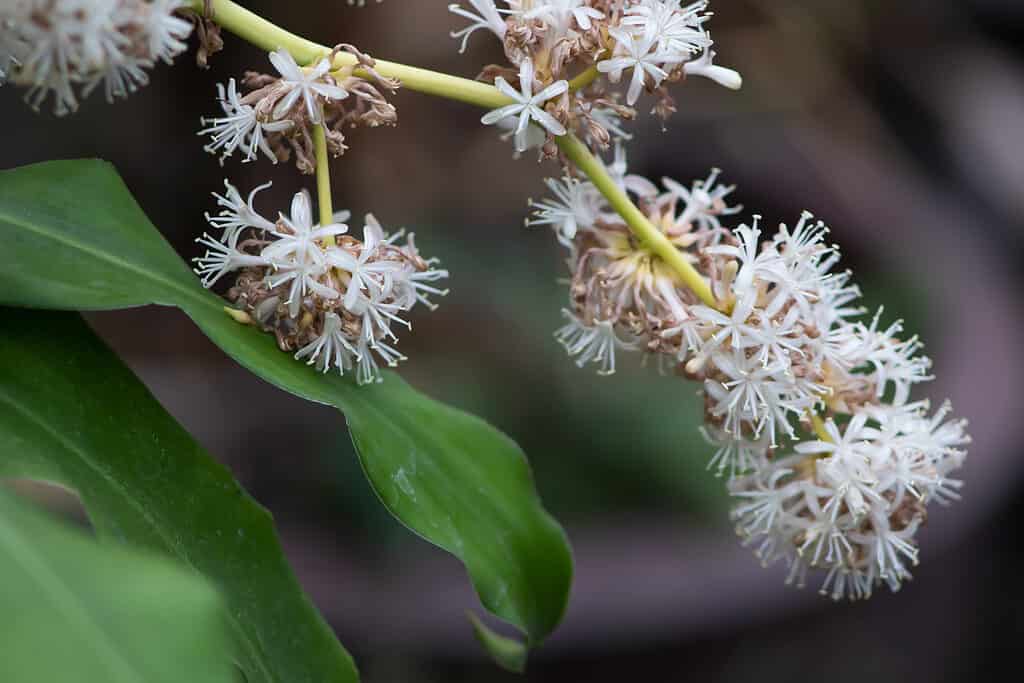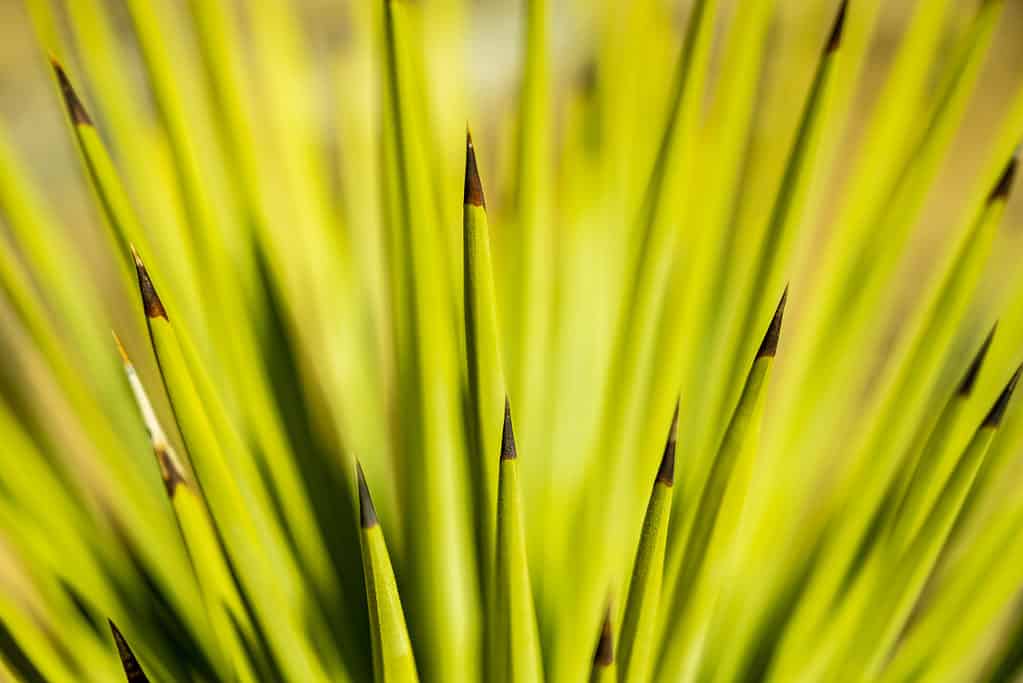In the case of corn plant vs. Yucca, the jury has reached a verdict: Both corn plants and Yucca are guilty of being fabulous. Whether they are growing as houseplants, adding a pop of color to an interior landscape, or growing outdoors in nature, these two plants are adored around the world.
Corn plants and Yucca often suffer from cases of mistaken identity. Both are popular houseplants with similar leaf structures, but they are not closely related, botanically speaking.
Read on to learn how to differentiate these plants, their growing habits, and how folks around the globe use these aesthetically pleasing plants!
Corn Plant vs. Yucca: Comparison
| Corn Plant | Yucca | |
|---|---|---|
| Genus | Dracaena | Yucca |
| Origin | Tropical Africa | North America, South America, and the Caribbean |
| Description | Slow-growing shrub with glossy green lance-like leaves; flowers in the wild, but unpredictable as a houseplant; mature plants reach heights of 40 feet or more | Slow-growing plant with tough, sword-shaped shiny green leaves; outdoor plants produce white flowers in spring; houseplants are unpredictable flowerer; generally 2-4 feet tall, with some species reaching 30 feet |
| Growing Zones | USDA Hardiness Zones 5-11; also grown as a houseplant | USDA Hardiness Zones 11-12; also grown as a houseplant |
| Toxicity | Yes, to small animals | Yes, to small animals |
Description / Growing Conditions:
Because corn plants and Yucca look very similar, they are often mistaken for each other. However, these two attractive plants have little in common.
Corn Plant: Outdoors
The corn plant (Dracaena fragrans) is native to tropical regions of Africa. As a tropical plant, it requires warmer temperatures, ideally between 60-80 degrees Fahrenheit. When corn plants are subjected to temperatures below 50 degrees Fahrenheit their leaves will curl and wither; these plants are not frost tolerant, and once the mercury dips below freezing (32 degrees Fahrenheit), corn plants die. Fortunately, corn plants make wonderful houseplants.

The corn plant is native to tropical regions of Africa.
©Sarida Bernadetha Munthe/Shutterstock.com
Simply because corn plants are not well-suited for growing outdoors in many places, doesn’t mean we have to forego their loveliness. A potted corn plant can add beauty and color to indoor spaces, too.
Corn Plant: Indoors
The corn plant is a tropical evergreen that has been a popular houseplant for nearly two hundred years. Introduced to Europe in the mid-19th century, and to the U.S. in the early 20th century, the corn plant is a beloved indoor plant revered for its striking foliage of long, slender, lance-shaped glossy green leaves, its thick, woody stalk, and its fragrant flowers. Dracaena fragrans is called a corn plant because its leaves were thought to resemble those of the corn (on the cob) plant, maize (Zea mays).

The corn plant is a beloved indoor plant revered
for its striking foliage of long, slender, lance-shaped glossy green leaves, its thick, woody stalk.
©Sachiczko/Shutterstock.com
This corn plant does not grow corn, but it does produce captivating, sweetly scented white flowers. Clusters of fragrant white flowers appear on these indoor plants in late fall to early winter. The flowers open in the evening, revealing their sweet scent. Both the flowers and their scent are reminiscent of jasmine (Jasminum). The highly scented blooms last about a week before withering.

The flowers open in the evening, revealing their sweet scent.
©sommai damrongpanich/Shutterstock.com
Corn plants are easy to care for where their foliage is concerned, but are somewhat unpredictable regarding their flowering. Upright and slender, corn plants grow well in bright rooms with indirect sunlight that are free from drafts. Corner spaces are ideal. Corn plants are drought tolerant in nature, so allow the soil to dry out between waterings. Though corn plants thrive in dry soil, they will not grow well in dry air. Humidity is a must for these indoor plants. Adding a humidifier to the plant’s space, and/or regularly misting it with water will keep it happy. Brown leaves are a sign of under-watering, while yellow leaves signal too much.
Corn plants are slow growing, and though mature plants can reach heights of 40 feet or more in nature, indoor plants will top out at approximately 6 feet, and then only after many years.
Yucca
The Yucca (Yucca) though similar in appearance to Dracaena fragrans, is a highly adaptable, cold hardy plant, with some varieties tolerating temperatures as low as minus 35 degrees Fahrenheit!
Yucca, a genus containing 40 or more species, is native to North America, South America, and the Caribbean. Their range in North America extends from Baja California, Mexico to Alberta, Canada.
Grown in nature as perennial shrubs or trees, Yuccas have long, tough, sword-like, shiny green leaves. Like swords, they develop sharp, dry thorn-like points on their leaf tips as they age. This is one of the easiest ways of determining whether a plant is a corn plant or a Yucca. Corn plants’ leaf tips will not feel prickly to the touch, no matter how old they are!

Yuccas have long, tough, sword-like, shiny green leaves that develop sharp, dry thorn-like points on their leaf tips as they age.
©iStock.com/kellyvandellen
Yuccas flower in the spring on a single, upright stem that emerges from the center of the plant. These stems can be 3 feet tall. Downward-facing tulip-shaped white six-petaled flowers line the length of the stem. Individual flower petals can be up to 2 inches long. Though not as fragrant as corn plants, Yucca’s flowers are lightly scented. It is this scent that attracts the Yucca’s sole pollinator, the Yucca moth. Yuccas also host the caterpillars that become Yucca giant-skippers (Megathymus yuccae), butterflies native to the Southern United States.

DYucca plants have downward-facing tulip-shaped white six-petaled flowers line the length of the stem. Individual flower petals can be up to 2 inches long.
©Sean Pavone/Shutterstock.com
Corn Plant vs. Yucca: Uses
Though both corn plants and Yucca are primarily thought of as ornamental houseplants, they are so much more than pretty plants designed for your viewing pleasure.
Yucca: Traditional Uses
The original inhabitants of North America utilized the tough, fibrous leaves of the Yucca plant to make rope. They would strip the leaves, peeling away layer after layer, rolling and twisting them together. The rope held objects together or in place. Sandals were also fashioned from this rope, which is similar to sisal. Indigenous people also made soap from Yucca’s roots, which create a lather when mixed with water.

The sandals fashioned out of Yucca rope might have looked similar to the ones pictured above.
©Noppakit 77/Shutterstock.com
Yucca: Modern Uses
Presently, Yucca plant extracts are ingredients in shampoo and hair-restoring agents. if the Yucca extracts don’t exactly regenerate hair growth, at least they can stop hair loss. Several products tout this property, some with more extraordinary claims than others, so as with any purchase, do your research before investing in Yucca shampoo.
Corn Plant vs. Yucca: Health benefits
However, the most amazing use of these plants is as air purifiers. Both corn plants and Yucca remove all sorts of dangerous elements from the air we breathe, replacing them with pure, clean oxygen.
It’s true! NASA (National Aeronautics and Space Administration), in partnership with the ALCA (Associated Landscape Contractors of America), studied the effects of different plants on air quality in enclosed environments, like those enormous multi-storied office buildings of the mid-to-late 20th century.

Corn plamts and Yucca temove dangerous chemicals from the air we breathe.
©Pixachi/Shutterstock.com
What they discovered is nothing short of amazing! Both of these plants are capable of removing dangerous chemicals from the air that we breathe. Although it seems a bit counterintuitive, human beings in developed countries are exposed to more dangerous pollutants indoors than out. Corn plants and Yucca, among a number of other ornamental plants, are topnotch at removing toluene, xylene, formaldehyde, benzene, carbon monoxide, and even lead from indoor spaces. These noxious chemicals can adversely affect the health of those who are consistently in buildings with poor air quality that contains them, the top three being high-rise office buildings, shopping malls, and school classrooms. Headaches, respiratory illnesses, and even more serious illnesses like cancer are related to prolonged exposure to these chemicals.
Corn plants and Yucca grown outdoors have similar effects on air quality, and water quality. Planted near farms and ranches, these plants (among others) can remove methane from the air, and ammonia from groundwater, both byproducts of animal husbandry.
What’s not to love about these two plants that are not only breathtakingly beautiful but also keep us healthy by cleaning the air that we breathe? The next time you find yourself in a high-rise or a shopping mall, be on the lookout for corn plants or Yucca, as you’re likely to see one or the other, if not both!
Yucca: Medicinal Uses
As if these plants haven’t already proven themselves fabulous enough, Yucca has one more surprise: The roots of several Yucca species are used in medicines that treat high blood pressure, high cholesterol, inflammation, arthritis, migraine headaches, diabetes, and others.

Yucca is an ingredient in medicines that treat high blood pressure.
©Prostock-studio/Shutterstock.com
So, whether you’re looking for an ornamental plant to spruce up your home, or a plant that can clear the air, look no further, as these two amazing plants can do both!
Of Note: Saponin, the organic compound found in Corn Plants and Yucca that is responsible for cleaning the air, is toxic to small animals, including cats and dogs. If you have pets, you might wish to reconsider bringing either of these plants, lovely as they are, home.
Up Next:
The photo featured at the top of this post is © ZayacSK/Shutterstock.com
Sources
- quora.com, Available here: https://www.quora.com/What-would-be-one-main-difference-between-dracaenas-and-yucca-plants
- gardeningknowhow.com, Available here: https://www.gardeningknowhow.com/houseplants/dracaena/how-to-tell-yucca-from-dracaena.htm
- ntrs.nasa.gov, Available here: https://ntrs.nasa.gov/citations/19930073077
- thebotanicalbarindy.com/, Available here: https://thebotanicalbarindy.com/blogs/blog/how-to-grow-and-care-for-corn-plant-dracaena
- molekule.com, Available here: https://molekule.com/blog/10-public-places-with-the-worst-indoor-air/
- ncbi.nlm.nih.gov, Available here: https://www.ncbi.nlm.nih.gov/pmc/articles/PMC1440857/
Thank you for reading! Have some feedback for us? Contact the AZ Animals editorial team.






